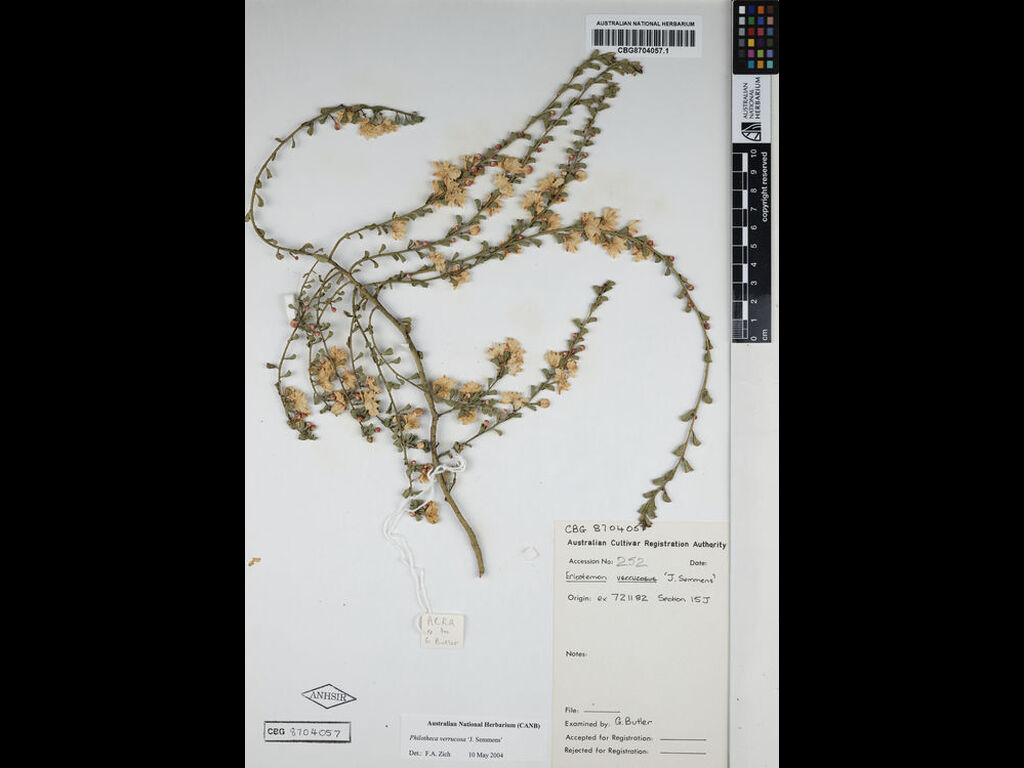Philotheca verrucosa 'J. Semmens'
- File Number
- 252
- ACRA Field Book Number
- 277
- Registration Date
- 18/10/1984
- Application Received
- -
- Family
- Rutaceae
- Cultivar Name
- Philotheca verrucosa 'J. Semmens'
- Origin
- Philotheca 'J. Semmens' was first found ca. 1910 on the property of the late Mr J Semmens in the Sedgwick Mandurang area, about 9 miles (14.5 kilometres) from Bendigo, Victoria. It is a form of P. verrucosa. Cultivar received by the Authority 22 September 1981. The applicant is the Bendigo Field Naturalists Club. Formerly:Eriostemon 'J Semmens'
- Characteristics
- This cultivar grows to 0.6m tall by 0.6m wide and its foliage is often sparse. The flowers are 15mm to 25mm across and consist of three layers of petals which surround petaloid stamens. The flowering season is August to October. All other characteristics of the cultivar are as for P. verrucosa. Diagnosis: The cultivar can be easily distinguished from the usual form of P. verrucosa by the multi-petalled flowers. Diagnosis: Other multi-petalled forms of P. verrucosa have been recorded, but material is not available for examination for difference. Written descriptions of the various forms appear similiar.
- Cultivation
- Philotheca 'J. Semmens' was discovered as the bush around it was about to be cleared. Mr Semmens erected a fence around the plant to ensure its survival. First recorded attempts at propagation were made by Rimingtons Nursery of Melbourne in the early 1930's. These attempts failed but success was finally achieved by establishing plants from root divisions. Plants were available for the general market by 1939. Best success at cultivation have been in very well drained soils in sunny, dry positions, with some protection from mid-afternoon sun. The cultivar is frost hardy and reasonably drought hardy.
- Publication
- Useful information on propagation may be found in the "Australian Plants" journal Vol.4, p.344, September 1968 Vol.4 p.346 and March 1961 Vol.2 p.11 (as 'J S Semmens') and "Shrubs and Trees for Australian Gardens", Fifth edition 1982, E. E. Lord and Dr J. H. Willis.
- Colour Coding
- RHS Colour Chart 1966. Flowers: back of petals: close to Red group 50C, front of petals: white group 155B.
- Propagation
- Cuttings from semi-firm new growth
- Applicant Name
- Bendigo Field Naturalists Club
- Uses
- As part of a mass planting or mixed in a shrubbery, or as a feature plant.
- Availability
- Specialist native plant nurseries
- ANBG Accession Numbers
- ACC252; ACRA277; CBG8704057
- NSL ID
- -


